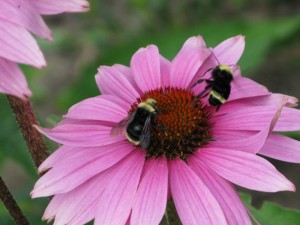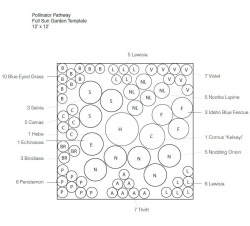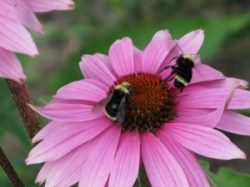
Photo by Abigail Joy.
Sarah Bergmann does not see herself as a political artist. Promoting social causes, raising awareness — that stuff doesn’t appeal to her. But she likes asking questions. Doing so, she says, “allows me to learn about the world and respond to it, and do something physical based on what I learn.”
Several years ago, Bergmann, a painter by training, started asking questions about the fate of the world’s pollinators. And while she’s not an environmentalist per se, Bergmann’s art and graphic design work never stray far from the environmental sphere. To her, the complex and shifting relationships between pollinators and plants have always begged further investigation. Bergmann’s response to what she learned is a work-in-progress called the Pollinator Pathway, a mile-long corridor of pollinator-friendly, mostly native plants stretching between two green spaces in the heart of Seattle.
Bergmann chose the pathway’s two endpoints — the Seattle University campus and a lot-sized forest called Nora’s Woods — for their diverse plant life and lack of pesticides. Since building the first test garden in 2008 with the help of a small city grant, she and hundreds of volunteers have installed 16 more gardens in parking strips along the way. “It’s not just a random line of plants; it’s meant to find two existing green spaces within the city and draw a line between them,” she says.
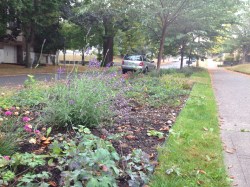
A garden on the Pollinator Pathway.
Gardens are built with the cooperation and enthusiasm of homeowners on the corridor, who have also agreed to maintain them. They must be drought-tolerant, pesticide free, and, ideally, contain at least 70 percent native plants — though Bergmann says the project hasn’t quite hit that target yet. And of course, the plants must be appealing to bees and other pollinators. These requirements, combined with city height restrictions for parking-strip vegetation, led to a list of about 50 plants that can be part of the pathway.
Parking strips are technically city property, but homeowners take responsibility for maintaining them. For most people, that means little more than picking up trash, pulling weeds now and then, and maybe planting a few decorative bulbs. Now Bergmann’s project reinvents these spaces as both functional and beautiful — which benefits not just birds and insects, but neighborhood residents, too.
“It’s not about flipping the land and turning it into a park,” Bergmann says. “It’s about finding what’s here and working with it. How can we work human systems and natural systems together in a really coherent way?”
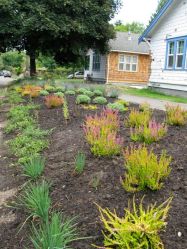
Photo by the Pollinator Pathway.
As Bergmann points out, the fact that some 50 percent of the world’s population now lives in urban areas represents “a real shift in the planet’s composition,” which in turn requires a shift in the way we approach landscape. Call it another aspect of the Anthropocene — we’re learning that wilderness and humanity can coexist in surprising ways. Projects like the Pollinator Pathway reimagine this relationship by showing how nature can thrive in the nooks and crannies of the city. That’s why, Bergmann explains, the pathway “doesn’t use more space than is already existing; it respects that the reason a city is sustainable is its compactness, and inserts something that makes sense into that pattern.” She likes to describe it as a “renegade park.”
Despite their critical role in keeping ecosystems functioning, pollinators in urban areas have not been the subject of much research beyond studies of small, specific areas, like individual gardens. To begin to fill the gap, the U.K.’s University of Bristol is running a three-year study investigating how city landscapes can support pollinators. Bergmann hopes the Pollinator Pathway can contribute to this small-but-growing body of knowledge: Before the gardens were planted, local high school and college students surveyed the number of pollinators already present in the neighborhood, and found virtually none. Now an entomologist from the Woodland Park Zoo monitors the gardens every week, tracking the range of pollinators that visit and which plants they prefer.
Bergmann and her network of volunteers plan to install several more gardens along the corridor this fall, but the project is far from finished. Eventually, she wants the Pollinator Pathway to be a model for other neighborhoods and cities. In the meantime, Bergmann emphasizes that you don’t have to live on the pathway to advance the larger goal of helping pollinators thrive. Anyone can follow the templates on the pathway’s website to make their own garden pollinator-friendly (although they are designed for the Pacific Northwest).
Ten Pollinator Pathways in each city in the U.S. won’t guarantee the salvation of our birds and bees and the labyrinth of life that depends on them. But it’s an approach to an ecological crisis that works with, rather than against, the human landscape — and that makes Bergmann cautiously hopeful. “I’m an optimist,” she says. “I don’t really have a lot of patience for anything else.”

